Grumman F8F-2 Bearcat Video
|
|
|
|
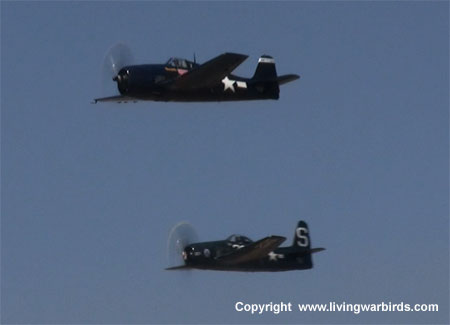 |
Manufacturer: Grumman Model: F8F-2 Year built: 1948 Serial Number: 122674 Number of Seats: 2 Number of Engines: 1 Engine Type: Reciprocating Engine: P&W R-2800 Series |
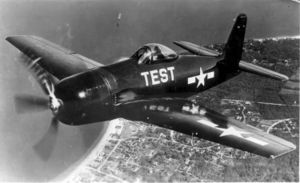 Role: Fighter aircraft
Role: Fighter aircraft
Manufacturer: Grumman
First flight: 21 August 1944
Introduction: 1945
Retired: 1955 (United States Navy), 1960 (Royal Thai Air Force)
Status: Retired
Primary users: United States Navy, United States Marine Corps, French
Air Force, Royal Thai Air Force
Number built: 1,266
The Grumman F8F Bearcat (affectionately called "Bear") was an American single-engine naval fighter aircraft of the 1940s. It went on to serve into the mid-20th Century in the United States Navy and other air forces, and would be the company's final piston engined fighter aircraft.
Design and development
Designed for the interceptor fighter role, the design team's aim was to create the smallest, lightest fighter that could fit around the Pratt & Whitney R2800 engine (carried over from the F6F Hellcat). Compared to its predecessor, the Bearcat was 20% lighter, had a 30% better rate of climb and was 50 mph (80 km/h) faster. It was also considerably smaller in size, as it was designed to be operated from small escort aircraft carriers, something the big Hellcat rarely did. Thus the F8F Bearcat was intended mainly as a replacement for the obsolete FM2 Wildcat, still the mainstay fighter of the many wartime escort carriers.
In comparison with the Vought F4U Corsair, the initial Bearcat (F8F-1) was marginally slower but was more maneuverable and climbed faster. Its huge 12' 4" Aero Products four-bladed propeller required a long landing gear (made even longer by the mid-fuselage position of the wing), giving the Bearcat an easily-recognized, "nose-up" profile. For the first time in a production Navy fighter, an all-bubble canopy offered 360-degree visibility.
The Bearcat concept was inspired by an evaluation in early 1943 of a captured Focke-Wulf Fw 190 fighter in England by Grumman test pilots and engineering staff. After flying the Fw 190, Grumman test pilot Bob Hall wrote a report he directed to President Leroy Grumman who personally laid out the specifications for Design 58, the successor to the Hellcat, closely emulating the design philosophy that had spawned the German fighter, although no part of the German fighter was copied. The F8F Bearcat would emanate from Design 58 with the primary missions of outperforming highly maneuverable late-model Japanese fighter aircraft such as the A6M-5 Zero, and defending the fleet against incoming airborne suicide (kamikaze) attacks.
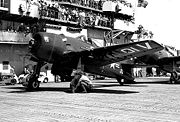 (Image: An F8F Bearcat aboard the USS Valley Forge)
(Image: An F8F Bearcat aboard the USS Valley Forge)
Unfortunately the target weight (derived from the land-based German aircraft) was essentially impossible to achieve as the aircraft had to be made stronger for aircraft carrier landings. As a weight-saving concept the designers came up with detachable wings; if the g-force exceeded 7.5g then the tips would snap off, leaving a perfectly flyable aircraft still capable of carrier landing. Unfortunately while this worked very well under carefully controlled conditions in flight and on the ground, in the field, where aircraft were repetitively stressed by landing on carriers and since the wings were slightly less carefully made in the factories, wings tended to break off while the vehicle bombed targets, and the aircraft would then crash. This was replaced with an explosives system to blow the wings off together, which also worked well, however this ended when a ground technician died due to accidental triggering. In the end the wings were reinforced and the aircraft limited to 7.5g.
Grumman's project pilot for the Bearcat series was legendary test pilot Corky Meyer, who also had this role on the F6F Hellcat, F7F Tigercat, F9F Panther, XF10F-1 Jaguar, and the F11F Tiger series. Meyer was head of Grumman Flight Operations at Edwards Air Force Base from 1952–56.
Another famous name is associated with the type; when asked his favorite aircraft to fly, Neil Armstrong's immediate and unequivocal answer was "Bearcat". Armstrong had flown the type in 1950 during his Navy Advanced Training, field qualifying in it at age 19.
Operational history
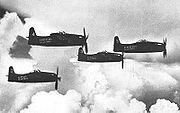 (Image: On 25 August 1946, the Blue Angels transitioned to the Grumman
F8F-1 Bearcat and introduced the famous "diamond" formation)
(Image: On 25 August 1946, the Blue Angels transitioned to the Grumman
F8F-1 Bearcat and introduced the famous "diamond" formation)
The F8F prototypes were ordered in November 1943 and first flew on 21 August 1944, a mere nine months later. The first production aircraft was delivered in February 1945 and the first squadron was operational by 21 May, but World War II was over before the aircraft saw combat service.
Postwar, the F8F became a major U.S. Navy fighter, equipping 24 fighter squadrons. Often mentioned as one of the best- (if not the best) handling piston-engine fighters ever built, its performance was sufficient to outperform many early jets. Its capability for aerobatic performance is illustrated by its selection for the Navy's elite Blue Angels in 1946, who flew it until the team was temporarily disbanded in 1950 (during the Korean War). The Grumman F9F Panther and McDonnell F2H Banshee largely replaced the Bearcat in USN service, as their performance and other advantages eclipsed piston-engine fighters.
An unmodified production F8F-1 set a 1946 time-to-climb record (after a run of 115 feet) of 10,000 feet in 94 seconds. The Bearcat held this record for ten years until it was broken by a modern jet fighter (which could still not match the Bearcat's short takeoff distance).
Other nations that flew the Bearcat included the French Air Force and Royal Thai Air Force. French aircraft saw combat service in the First Indochina War as fighter-bombers in the early 1950s. Nearly 70 surviving aircraft passed to the Vietnam Air Force upon its creation in 1955.
 (Image: F8F-2 Bearcat N5555H, flown by N.R. Hanson (1924–1967),
Yale's "Flying Professor", in the 1960s)
(Image: F8F-2 Bearcat N5555H, flown by N.R. Hanson (1924–1967),
Yale's "Flying Professor", in the 1960s)
Air racing
Bearcats have long been popular in air racing. A stock Bearcat flown by Mira Slovak and sponsored by Bill Stead won the first Reno Air Race in 1964. Rare Bear, a highly-modified F8F owned by Lyle Shelton, went on to dominate the event for decades, often competing with Daryl Greenamyer, another famous racer with his own Bearcat victories and a Bearcat world speed record. Rare Bear also set many performance records, including the 3 km World Speed Record for piston-driven aircraft (528.33 mph (850.26 km/h), set in 1989), and a new time-to-climb record (3,000 meters in 91.9 seconds, set in 1972, breaking the 1946 record cited above).
Surviving aircraft
(Image: Record-breaking Rare Bear racer)
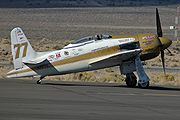 A small number of Bearcats survive:
approximately 11 are airworthy (several as racing aircraft), eight
are restored for static display and approximately a dozen more are wrecks
or restoration projects.
A small number of Bearcats survive:
approximately 11 are airworthy (several as racing aircraft), eight
are restored for static display and approximately a dozen more are wrecks
or restoration projects.
Specifications (F8F-1)
General characteristics
Crew: 1 pilot
Length: 28 ft 3 in (8.6 m)
Wingspan: 35 ft 10 in (10.9 m)
Height: 13 ft 10 in (4.2 m)
Wing area: ft² (m²)
Empty weight: 7,070 lb (3,210 kg)
Loaded weight: 9,600 lb (4,400 kg)
Max takeoff weight: 12,947 lb (5,870 kg)
Powerplant: 1x Pratt & Whitney R-2800-34W "Double Wasp" two-row
radial engine, 2,100 hp (1,567 kW
 (Image: Grumman F8F-2P Bearcat G-RUMM N700HL at at Flying Legends, Duxford,
UK)
(Image: Grumman F8F-2P Bearcat G-RUMM N700HL at at Flying Legends, Duxford,
UK)
Performance
Maximum speed: 421 mph (366 knots, 678 km/h)
Range: 1,105 mi (1,780 km)
Service ceiling 38,700 ft (11,800 m)
Rate of climb: 4,570 ft/min (23.2 m/s)
Power/mass: 0.22 hp/lb (360 W/kg)
Armament
Guns: 4× 0.50 in (12.7 mm) machine guns
Rockets: 4× 5 in (127 mm) unguided rockets
Bombs: 1,000 lb (450 kg) bombs
Source: WikiPedia